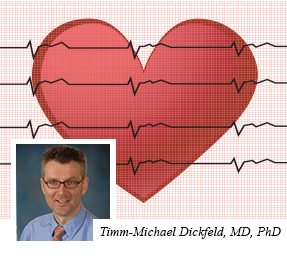UMMC at Forefront of Ventricular Tachycardia Mapping Efforts

Growing survival rates after major heart attacks and heart failure in general are among the top factors fueling University of Maryland Medical Center's (UMMC) acclaimed efforts to develop 3-D imaging approaches improving the success rates of catheter ablation treatment for the life-threatening erratic heartbeat known as ventricular tachycardia.
For more than a decade, Timm-Michael Dickfeld, MD, PhD, (Division of Cardiology and Electrophysiology), Jean Jeudy, MD (Radiology), and Vasken Dilsizian, MD (Nuclear Medicine) have been researching and developing leading-edge, image-guided mapping techniques (such as myocardial perfusion and metabolism with PET/CT, cardiac innervation with SPECT, and delayed enhancement with MRI) enabling clinicians to identify scarred areas on the heart muscle responsible for ventricular tachycardia. The scars are then treated with radiofrequency ablation, which can represent a cure for the condition.
"When I came to UMMC in 2005, we started to build a portfolio of all the imaging technologies that could help us better understand abnormal heart muscle," says Dr. Dickfeld, also an associate professor of medicine at University of Maryland School of Medicine. "working with Drs. Jeudy and Dilsizian, we've built a portfolio that is one of the leading ones in the world allowing us to better understand ventricular tachycardia. We are at the side of our patients to make sure they live meaningful lives even with life-threatening heart arrhythmias."
Aiming at Higher Success Rates for Catheter Ablation Treatment
Ventricular tachycardia is a major contributor to the 450,000 cases of sudden cardiac death occurring in the United States each year. Scar tissue on the heart muscle resulting from heart attacks or cardiomyopathy cause the heart's ventricles to beat at a rapid rate — often between 120 and 300 beats per minute — and can progress to ventricular fibrillation, an uncoordinated heart rhythm that can lead to sudden death.
About 300 patients come to UMMC each year for heart arrhythmia treatment, Dr. Dickfeld says, with approximately 50 undergoing 3-D mapping of cardiac anatomy, blood flow, metabolism and innervation in order to pinpoint scar tissue contributing to their erratic heartbeat.
Symptoms of ventricular tachycardia — which include palpitations, dizziness, lightheadedness or fainting — are initially tackled with first-line treatments such as medication especially if frequent shock treatments of internal cardiac defibrillators occur. But these repeated jolts leave many patients in fear of the next shock, Dr. Dickfeld notes, and medication is often less effective as months and years pass.
Catheter ablation spares patients repeated shocks by fixing the scar tissue causing erratic heart rate, but it’s not always effective either. Dr. Dickfeld and his team are working to improve success rates, since 47% of patients experience a recurrence of ventricular tachycardia six months after the procedure. "There's room for improvement," he says. "It would be better if there were only a 30% or less recurrence rate."
UMMC Spearheads Pivotal Research
To that aim, Dr. Dickfeld, in collaboration with Drs. Dilsizian and Jeudy, has spearheaded widely published research over the last dozen years that incorporates imaging technologies such as CT, MRI and PET scans to increase the accuracy of catheter ablation therapy. The 3-D images resulting from combining technologies is used along with electrical mapping, to help clinicians detect variations in the heart's electrical signals as an electrode — inserted in the groin and threaded to the beating heart — is moved a few millimeters at a time. Scarred areas causing electrical disturbances are then ablated with the heated probe, negating their effect.
Dr. Dickfeld's efforts have received worldwide recognition, and he's often asked to speak at national and international scientific conferences. "University of Maryland has become one of the well-respected centers in this field," he says.
With ventricular tachycardia image-guided mapping technology's well-established abilities to determine which areas of the heart are abnormal, Dr. Dickfeld hopes future efforts will distinguish "bad scars" from "good scars" that don't require ablation treatment. He also hopes the technology will evolve to enable an even more proactive approach.
"We hope to even treat potential areas of the heart that will become a problem six or eight months down the line," Dr. Dickfeld says.
Appointments can be made at 410-328-6056.
